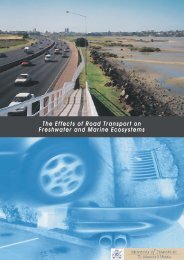National Freight Demands Study - Ministry of Transport
National Freight Demands Study - Ministry of Transport
National Freight Demands Study - Ministry of Transport
You also want an ePaper? Increase the reach of your titles
YUMPU automatically turns print PDFs into web optimized ePapers that Google loves.
<strong>National</strong> <strong>Freight</strong> <strong>Demands</strong> <strong>Study</strong><br />
Pulp and paper<br />
Total pulp production in New Zealand in 2006-07 was about 1.5 million tonnes. Using<br />
ratios developed by Veltman a tonne <strong>of</strong> pulp typically requires about 2.5-3 tonnes <strong>of</strong><br />
inputs, with these typically in the range <strong>of</strong> 60-70 percent logs and 30-40 percent<br />
residues, although this can vary significantly for individual plants. On this basis about<br />
three million tonnes <strong>of</strong> logs would be required and up to about 1.5 million tonnes <strong>of</strong><br />
residues.<br />
Paper is manufactured mainly from pulp with one tonne <strong>of</strong> pulp producing about 1.7<br />
tonnes <strong>of</strong> paper. In 2006-07 about 0.9 million tonnes <strong>of</strong> paper was produced in New<br />
Zealand, using about 0.4 million tonnes <strong>of</strong> pulp and also some recycled paper collected<br />
from various collection points mainly in the North Island. For example, Carter Holt<br />
Harvey (CHH) recycles paper from a number <strong>of</strong> collection points which is then<br />
transported to their mill in Penrose in Auckland.<br />
About three million tonnes per annum <strong>of</strong> the log harvest goes to pulp and paper, in<br />
addition to the mill residue referred to above. There are eight mills producing either pulp<br />
or paper or both in New Zealand, all <strong>of</strong> them in the North Island and half in Eastern Bay<br />
<strong>of</strong> Plenty. Again the output goes to either local markets or export. Some information on<br />
the capacity <strong>of</strong> the pulp and paper mills is available from published sources and this is<br />
set out in Table 3.16.<br />
Table 3.16<br />
Pulp and paper mill capacities<br />
Company Mill Pulp and paper capacity<br />
(tonnes)<br />
CHH Kinleith 605,000<br />
CHH Tasman (Kawerau) 270,000<br />
CHH Whakatane 115,000<br />
CHH Penrose 80,000<br />
PanPac Whirinaki 260,000<br />
Source: company websites<br />
The sources <strong>of</strong> timber for the pulp mills are assumed to be as close to the mills as<br />
possible. Results from the interviews indicated that this could involve distances <strong>of</strong> up to<br />
about 300 kms between forest and mill, although the average distance is much smaller,<br />
probably in the range <strong>of</strong> 100-150 kms.<br />
A total <strong>of</strong> 1.6 million tonnes <strong>of</strong> pulp and paper was exported in 2006-07. This is set out<br />
above in Table 3.11. Given the mill locations it is not surprising that Tauranga is the<br />
dominant port for exports. Local consumption <strong>of</strong> paper has been assessed in part using<br />
data from manufacturers and in part on the basis <strong>of</strong> a constant average consumption per<br />
person. The pattern <strong>of</strong> distribution has been assessed to balance the estimated supply<br />
and demand and takes into account the patterns reported by the firms interviewed.<br />
The estimated pattern <strong>of</strong> movements into and out <strong>of</strong> the pulp mills is set out in Table<br />
3.17.<br />
34
















